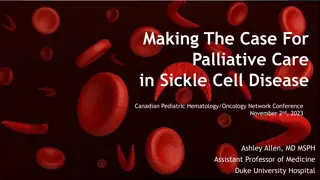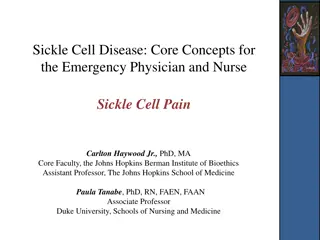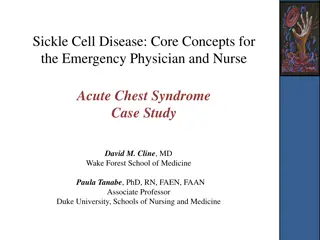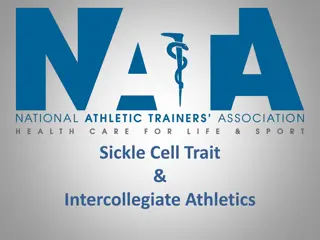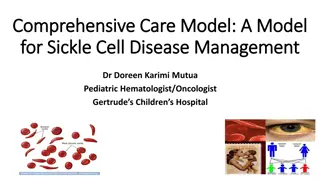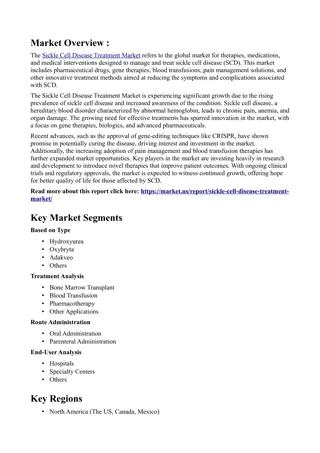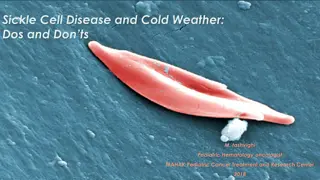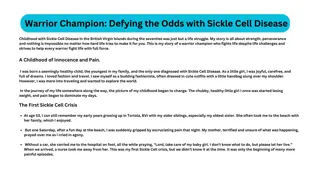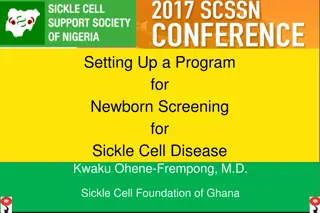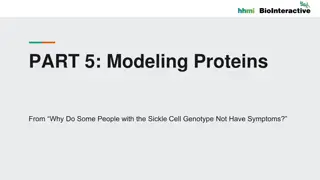Understanding Sickle Cell Disease: Core Concepts for Healthcare Professionals
Sickle Cell Disease (SCD) is a genetic disorder primarily affecting individuals of African descent but also found in other ethnic groups. The most severe form is sickle cell anemia (SS), presenting with life-threatening complications. This article explores the epidemiology, genotypes, and changes in life expectancy associated with SCD, emphasizing the importance of early intervention and appropriate management strategies.
Download Presentation

Please find below an Image/Link to download the presentation.
The content on the website is provided AS IS for your information and personal use only. It may not be sold, licensed, or shared on other websites without obtaining consent from the author. Download presentation by click this link. If you encounter any issues during the download, it is possible that the publisher has removed the file from their server.
E N D
Presentation Transcript
Sickle Cell Disease: Core Concepts for the Emergency Physician and Nurse Epidemiology, Genetics, Pathophysiology Paula Tanabe, PhD, RN, FAEN, FAAN Associate Professor Duke University, Schools of Nursing and Medicine
Objectives Identify the genotype associated with the most severe form of sickle cell disease (SCD) Identify the median lifespan for individuals with SCD
Pretest- Question 1 Which genotype is associated with the most severe symptoms? a. SS b. SC c. SB0 d. SB+
Pretest- Question 2 What is the median lifespan for most individuals with SCD? a. 20 s b. 30 s c. 40 s d. 50 s
Epidemiology of SCD SCD is a genetic disease affecting70,000 100,000 Americans, primarily of African descent 1 Most common genetic disease among blacks SCD occurs in 1 of every 500 black births 1:1,100 Hispanics (eastern states) 1:32,000 Hispanics (western states) SCD occurs in many other ethnic groups, including Northern Europeans and those that live in the Middle Eastern Countries 1:12 African-Americans are carriers (trait) for the disorder
SCD Common Genotypes Genotype Sickle cell anemia (SS, most severe form) Sickle/Hb C disease (SC, lesser severity, but can still have pain episodes, and life-threatening complications) Sickle/Beta plus thalassemia (S + thalassemia, similar to SC) Sickle/Beta zero thalassemia (S thalassemia, similar to SS) Approximate % of US Patients 65 % 25 % 8 % 2 %
Comparison of Life Expectancy US Population vs. Sickle Cell Disease
Changes in Life Expectancy National Center for Health Statistics 3 Compared 1999-2007 with 1979-1998 Largest declines in ages 0-4 Smaller but significant declines up to age 19 Due to prophylactic treatment with penicillin and vaccinations Transcranial doppler screening identifies children at risk of stroke; placed on chronic transfusion therapy to prevent stroke No differences in the 20-24 age group Increase in death rate ages: 45-54, 55-65, and 65-75
Normal Vs. Sickle Red Cells Normal Biconcave disc-shaped Deformable Life span of 120 days Sickle Sickle-shaped Rigid Life span of 20 days or less Sticky surface, abnormal properties
Prolonged Sickling of RBCs After recurrent episodes of sickling membrane damage occurs cells not capable of resuming biconcave shape upon re- oxygenation Deformed sickle cells adhere to endothelium & macrophages induces hemolytic process
Hemolysis and Vaso-occlusion Hemolysis Anemia in SCD is caused by red cell destruction, or hemolysis Vaso-occlusion: Complex process initiated by rigid and abnormally shaped sickled RBC s Degree of anemia varies widely between patients Abnormal adhesion occurs to the endothelium Red cell production by the bone marrow increases dramatically, but is unable to keep pace with the destruction Activation of WBC s, RBC s & the endothelial surface which enhances the VOC process Results in tissue damage, hypoxia, necrosis, & organ dysfunction
Acute and Chronic Manifestations Acute Manifestations Chronic Manifestations Anemia Jaundice Splenomegaly Functional asplenia Cardiomegaly and functional murmurs Hyposthenuria and enuresis Proteinemia Cholelithiasis Delayed growth and sexual maturation Restrictive lung disease* Pulmonary hypertension* Avascular necrosis Proliferative retinopathy Leg ulcers Transfusional hemosiderosis* Bacterial sepsis or meningitis* Recurrent vaso-occlusive pain (dactylitis, musculo-skeletal or abdominal pain) Splenic sequestration* Aplastic crisis* Acute chest syndrome* Stroke* Priapism Hematuria, including papillary necrosis *Potential cause of mortality
Clinical Scenario Cut and paste this link into your browser to view this short video https://www.youtube.com/watch?v=Uu5VTET lbZM&feature=youtu.be
Posttest- Question 1 Which genotype is associated with the most severe symptoms? a. SS b. SC c. SB0 d. SB+
Posttest- Question 2 What is the median lifespan for most individuals with SCD? a. 20 s b. 30 s c. 40 s d. 50 s
Posttest Answers & Rationale Question 1 Answer : a) SS Rationale: Patients with SS have the most severe form of the disease which is associated with more complications. However, all patients can experience pain and multiple other complications. Question 2 Answer: c) 40 s Rationale: The median lifespan continues to be 48 for females and 42 for males.
References 1. Hassell KL. Population estimates of sickle cell disease in the U.S. Am J Prev Med. 2010;38(4S):S512-S521. 2. Platt et al. Mortality in sickle cell disease, life expectancy and risk factors for early death. NEJM 1994. 330: 1639-44. 3. Hamideh, D. Trends in Mortality Among Patients with SCD in the United States. Is there any change in the past 10 years? 2012. 6th Annual Sickle Cell Disease Research and Educational Symposium & Annual National SCD Scientific Meeting 4. http://wonder.cdc.gov/controller/datarequest/D79




